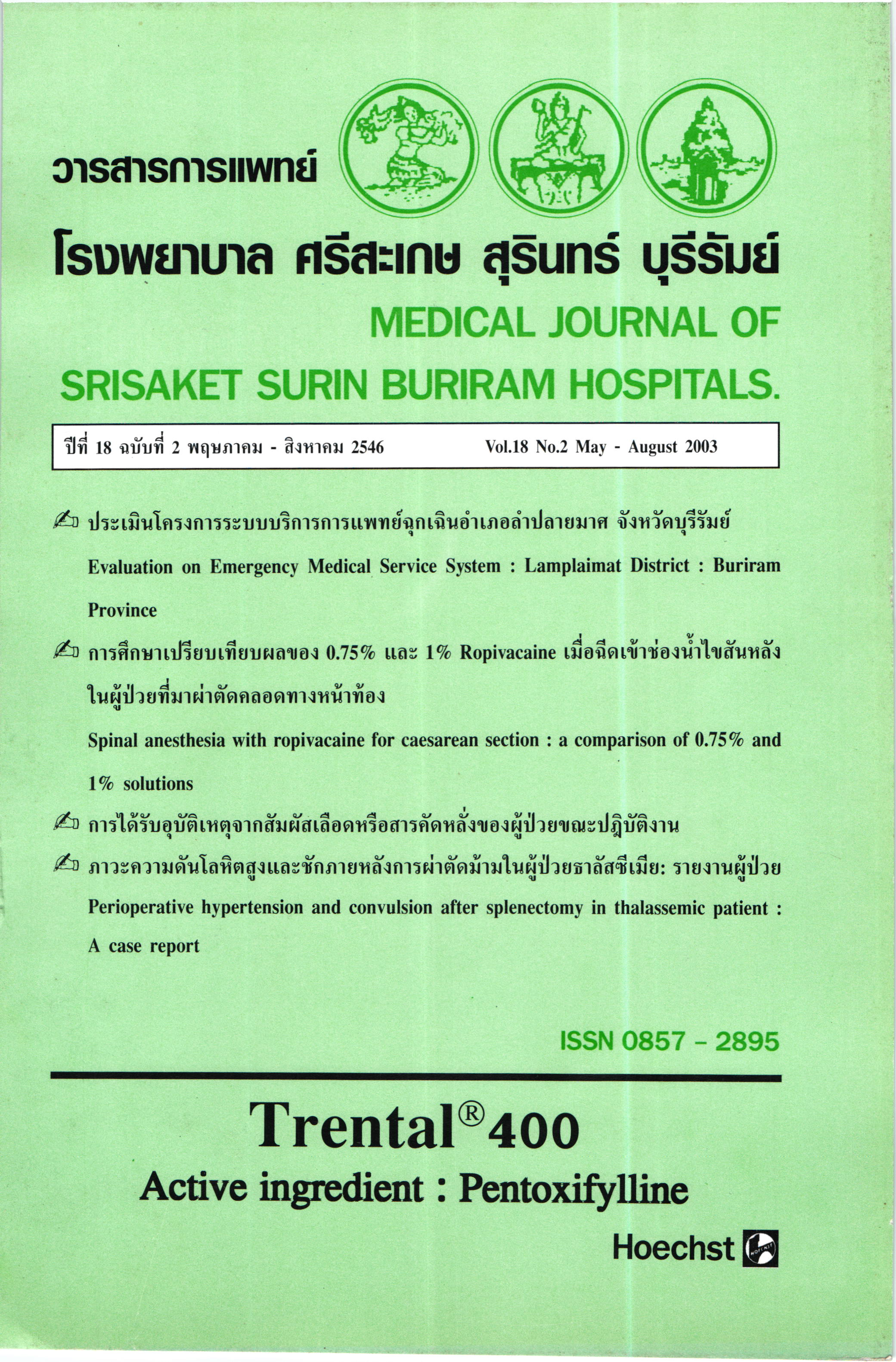การศึกษาเปรียบเทียบผลฃอง 0.75% และ 1% Ropivacaine เมื่อกีดเข้าช่องนํ้าไขสันหลังในผู้ป่ายที่มาผ่าตัดคลอดทางหน้าท้อง
Main Article Content
บทคัดย่อ
วัตถุประสงค์: ศึกษาผลของการฉีด 0.75% ropivacaine เปรียบเทียบกับ 1% ropivacaine 2.5 มล.เท่ากัน เข้าช่องไขสันหลังในผู้ป่วยไทย
รูปแบบการวิจัย: Randomized trial
สถานที่ศึกษา: กลุ่มงานวิสัญญีวิทยา โรงพยาบาลสุรินทร์
กลุ่มตัวอย่าง: ผู้ป่วยที่ได้รับการผ่าตัดคลอดทางหน้าท้อง ตั้งแต่วันที่ 1 พฤษภาคม พ.ศ.2545 ถึง วันที่ 31 มกราคม พ.ศ.2546 จำนวน 104 ราย
ผลการศึกษา: ผูป๋วยทสามารถทำผ่าตัดได้สำเร็จด้วย spinal ropivacaine กลุ่มทีได้รับยา 0.75 % ropivacaine มีจำนวน 88.46 % เปรียบเทียบกับกลุ่มที่ได้รับ ยา 1 % ropivacaine มีจำนวน 96.15 % พบว่าความแรงของการชาและการอ่อน แรงของกล้ามเนื้อสัมพันธ์กับ ขนาดของยาชาเฉพาะที่ โดยพบว่าการเพิ่ม ขนาด1ของยาชาท่า'ให้เพิ่มระยะเวลา'ของการชาและการอ่อนแรงของกล้ามเนื้3 ส่งผลถึงระยะเวลาการลดระดับของการชาและการกสับมีแรงของกก้ๅมเนื้อรๆม ทั้งระยะเวลาที่ต้องการยาแก้ปวดก็นานออกไป แต่พบว่าไม่มีความสัมพันธ์กับ ระยะเวลาที่ยาเริ่มออกฤทธิ้
สรุป: ropivacaine เป็นทางเลือกที่เหมาะสมใน spinal anesthesia สำหรับการผ่าตัด คลอดทางหน้าท้อง โดยใช้ขนาด18.75 และ 25 มิลลิกรัม ได้ผลดี และมี ความปลอดภัยในผู้ป่วยไทย
Article Details
เอกสารอ้างอิง
2. Kristensen JD, Karlsten R, Gordh T : Spinal cord blood flow after intrathecal injection of ropivacaine and bupivacaine with or without epinephrine in rats.Acta Anaesthesiol Scan 1998;42(6):685-90
3. McClellan KJ, Faulds D : Ropivacaine : an update of its use in regional anaesthesia. Drugs 2000;60(5):1065-93
4. Casati A, Santorsola R, Cerchierini E. Moizo E : Ropivacaine. Minerva Anestesiol 2001;67(9 Suppl 1):15-9
5. Gautier PE, De Kock M.Van Steenberge A, Poth N, Lahaye-Goffart B. Fanard L, Hody JL : Intrathecal ropivacaine for ambulatory surgery. Anesthesiology 1999;91(5):123945
6. McDonald SB. Liu SS. Kopacz DJ. Stephenson CA : Hyperbaric spinal ropivacaine : a comparison to bupivacaine in volunteers. Anesthesiology 1999;90(4):971-7
7. Wahedi W. Nolte H. Klein P : Ropivacaine for spinal anaesthesia : a dose-finding study. Anesthesist 1996;45(8):737-44
8. Chung CJ.Choi SR.Yeo KH.Park HS.Lee SI, Chin YJ : Hyperbaric spinal ropivacaine for cesarean delivery : a comparison to hyperbaric bupivacaine. Anesth Analg 2001;93(1):157-61
9. Khaw KS, Ngan Kee WD, Wong M. Ng F, Lee A : Spinal ropivacaine for cesarean delivery : a comparison of hyperbaric and plain solutions. Anesth Analg 2002;94(3):680-5
10. McConachie I, McGeachie J : A Practice of Anaesthesia 6th Edition by Wylie and Churchill-Davidson’s : 717
11. เพชรา ชำนาญกิจโกศล, โฉมชบา สิรินันท์, เพลิน สำราญใจ, มนต์ชัย แก้วเจริญ, อัสนี ศรนิล.Low dose Intrathecally Bupivacaine for Cesarean Section. วิสัญญีสาร 2002;28(4):192-8
12. Wacharin S, Ruenreong L, Wipada T, Klinchan P : A Questionnaire for Measuring maternal satisfaction to regional anesthesia for Caesarean section. ASEAN Journal of Anaesthesiology 2002;3(2):65-72
13. Kim S. Khaw, Warwick D. Ngan Kee, Eliza L. Y. Wong, Justina Y. W. Liu, Raymond Chung : Spinal ropivacaine for cesarean section : a dose-finding study. Anesthesiology 2001;95(6):1346-50
14. Malinovsky JM,Charles F, Kick o, Lepage JY, Malinge M, Cozian A, Bouchot o, Pinaud M : Intrathecal anesthesia : ropivacaine versus bupivacaine. Anesth Analg 2000;91(6):1457-60
15. McNamee DA, Parks L, McClelland AM, Scott S, Milligan KR, Ahlen K, Gustafsson U : Intrathecal ropivacaine for total hip arthroplasty : double-blind comparative study with isobaric 7.5 mg ml (-1) and 10 mg ml (-1) solutions.Br J Anaesth 2001;87(5):743-7
16. van Kleef JW, Veering BT.Burm AG : Spinal anaesthesia with ropivacaine : a double-blind study on the efficacy and safety of 0.5% and 0.75% solutions in patients undergoing minor lower limb surgery. Anesth Analg 1994;78(6):1125-30
17. วรรณา สมบูรณ์วิบูลย์, ฐิติมา ชินะโชติ, สุปราณี นิรุตติศาสน์, เกศชาดา เอื้อไพโรจน์กิจ, นุชสโรช เพ็ชญไพคิษฎ์, พรรณิกา วรผลึก, นาตยา พละพลีวัลย์, เฉลิมพล ทองรมย์, คิริวัน วนแสงสกุล. Efficacy of 1% Ropivacaine Epidurally in Thai Patients. วิสัญญีสาร 2000;26(2):86-93


